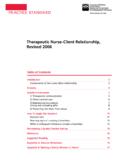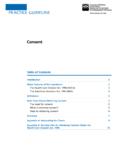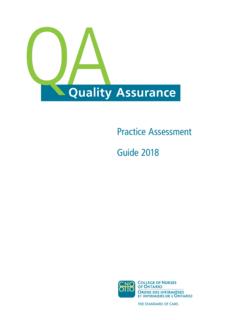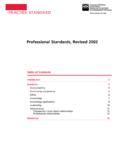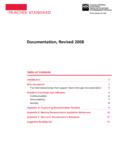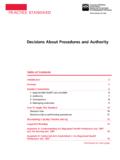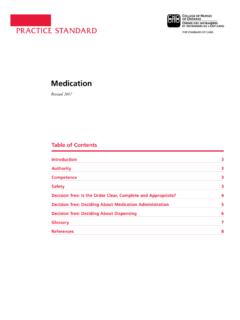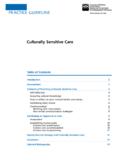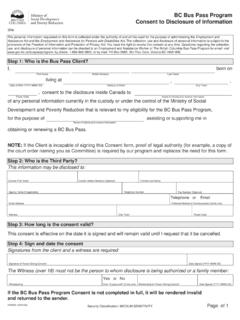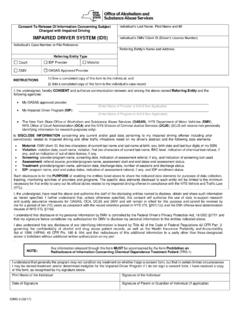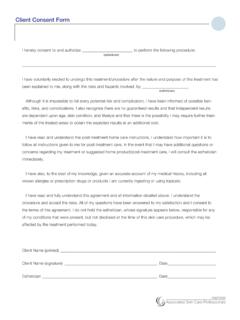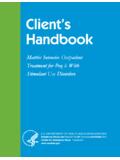Transcription of PRACTICE STANDARD Confdi entaitily and Prvi acy — …
1 PRACTICE STANDARDT able of Contents Introduction 3 Understanding the Personal Health information Protection Act 4 What is personal health information ? 4 Application throughout the health care continuum 4 How the Personal Health information Protection Act affects nurses 5 Personal health information belongs to the client 6 Disclosure 7 Professional misconduct 7 STANDARD Statements 8 Personal health information practices 8 Knowledgeable consent and substitute decision-makers 9 The client s right to access and amend his/her personal health information 9
2 Potential for harm 10 Disclosure without consent 10 Maintaining a Quality PRACTICE Setting 11 Case Scenarios 12 References 14 Confidentiality and Privacy Personal Health InformationConfidentiality and Privacy - Personal Health information Pub. No. 41069 ISBN 978-1-77116-052-0 Copyright College of Nurses of Ontario, or for-profit redistribution of this document in part or in whole is prohibited except with the written consent of CNO. This document may be reproduced in part or in whole for personal or educational use without permission, provided that: Due diligence is exercised in ensuring the accuracy of the materials reproduced; CNO is identified as the source; and The reproduction is not represented as an official version of the materials reproduced, nor as having been made in affiliation with, or with the endorsement of, published 2004, Reprinted December 2005, May 2008.
3 Updated June 2009. Updated February copies of this document may be obtained by contacting CNO s Customer Service Centre at 416 928-0900 or toll-free in Ontario at 1 800 of Nurses of Ontario 101 Davenport Rd. Toronto, ON M5R fascicule existe en fran ais sous le titre : Confidentialit des renseignements personnels sur la sant , n 51069 VISION Leading in regulatory excellenceMISSION Regulating nursing in the public interestPRACTICE STANDARD3 College of Nurses of Ontario PRACTICE STANDARD : Confidentiality and Privacy Personal Health InformationNursing standards are expectations that contribute to public protection.
4 They inform nurses of their accountabilities and the public of what to expect of nurses. standards apply to all nurses regardless of their role, job description or area of PRACTICE . College of Nurses of OntarioIntroduction Nurses1 have ethical and legal responsibilities to maintain the confidentiality and privacy of client health information obtained while providing care. One way that nurses maintain boundaries and build nurse-client relationships based on trust is by respecting clients rights around confidentiality and privac s privacy legislation supports and extends the College of Nurses of Ontario s (CNO s) standards on nurses accountabilities pertaining to clients personal health information .
5 This document provides an overview of Ontario s current legislation, clarifies nursing standards for confidentiality and privacy of personal health information , and replaces the Confidentiality PRACTICE guideline (#41045). It also updates the information on security and confidentiality of personal health information in the Documentation, Revised 2008 and Ethics PRACTICE Personal Health information Protection ActThe Personal Health information Protection Act, 2004 (PHIPA) governs health care information privacy in Ontario.
6 information privacy is defined as the client s right to control how his/her personal health information is collected, used and disclosed. PHIPA sets consistent rules for the management of personal health information and outlines the client s rights regarding his/her personal health information . This legislation balances a client s right to privacy with the need of individuals and organizations providing health care to access and share health information . PHIPA permits the sharing of personal health information among health care team members to facilitate efficient and effective care.
7 The health care team includes all those providing care to the client, regardless of whether they are employed by the same organization. PHIPA requires that personal health information be kept confidential and secure. Security refers to the processes and tools that ensure confidentiality of information . When using computers, nurses should refer to the Documentation, Revised 2008 PRACTICE Quality of Care information Protection ActThe Quality of Care information Protection Act, 2016 (QOCIPA) is another piece of legislation for the health care sector.
8 This Act provides broad protection to quality of care information produced by a health care facility or a health care entity, or for a governing or regulatory body. Its purpose is to promote open discussion of adverse events, peer review activities and quality of care information , while protecting this information from being used in litigation or accessed by clients . This means that nurses activities and records associated with the College s Quality Assurance Program cannot be used in legal proceedings. 1 In this document, nurse refers to a Registered Practical Nurse (RPN), Registered Nurse (RN) and Nurse Practitioner (NP).
9 PRACTICE STANDARD4 College of Nurses of Ontario PRACTICE STANDARD : Confidentiality and Privacy Personal Health InformationUnderstanding the Personal Health information Protection ActWhat is personal health information ?Personal health information is any identifying information about clients that is in verbal, written or electronic form. This includes information collected by nurses during the course of therapeutic nurse-client relationships. Such information relates to the following: physical or mental health, including family health history; care provided (including the identification of people providing care); a plan of service (under the Long Term Care Homes Act, 2007); payments or eligibility for health care; donation of body parts or substances ( , blood), or information gained from testing these body parts or substances; a person s health number.
10 Or the name of a client s substitute do not have to be named for information to be considered personal health information . information is identifying if a person can be recognized, or when it can be combined with other information to identify a person. Personal health information can also be found in a mixed record, which includes personal information other than that noted above. A personnel record containing a note from a physician or an NP supporting an absence from work is not considered personal health information .
